Kieran Mulholland was an elected representative for Sinn Féin on the Causeway Coast and Glens Borough Council from 2014-2019. He works in data analysis and data science in the private sector.
As the MLAs embark on their new positions in the Assembly, you’ll have noticed the great announcements on social media of their Written Questions to Ministers. Indeed, Justin McNulty’s first tweet post-helicopter (and whip removal) was an ode to his Written Question to the Minister for Communities regarding the Casement Park project.
🏗️ Let’s build @CasementPark pic.twitter.com/JYvs9KCSBY
— Justin McNulty (@JustinMcNu1ty) February 6, 2024
You may also have noticed the Justice Minister Naomi Long lamenting the potential cost in time and money for Jim Allister’s Written Questions in particular.
As you read these questions, bear in mind that each one can cost up to £700 to answer, not to mention deflecting officials away from important delivery for people.
They're a crucial part of the democratic process, but they ought not to be abused for party politicking. https://t.co/5O7JPPmVI4
— Naomi Long MLA (@naomi_long) February 5, 2024
The rules allow for MLAs to table up to 5 written questions per day. These should be answered by the department in question within ten working days. They may also designate one question per day for priority answer so it must be responded to within 2 to 5 working days.
So with a week now complete, which MLAs have been utilising this facility, and what are the common themes arising?
Well, there was a total of 684 written questions submitted across the week for all departments – almost 140 per day. Alliance led the way in total questions with 169, followed closely by the SDLP at 157 as they settle into their official opposition role. Interestingly, the two Independent candidates Claire Sugden and Alex Easton combined, eclipsed Sinn Féin’s total (the Assembly’s largest party).
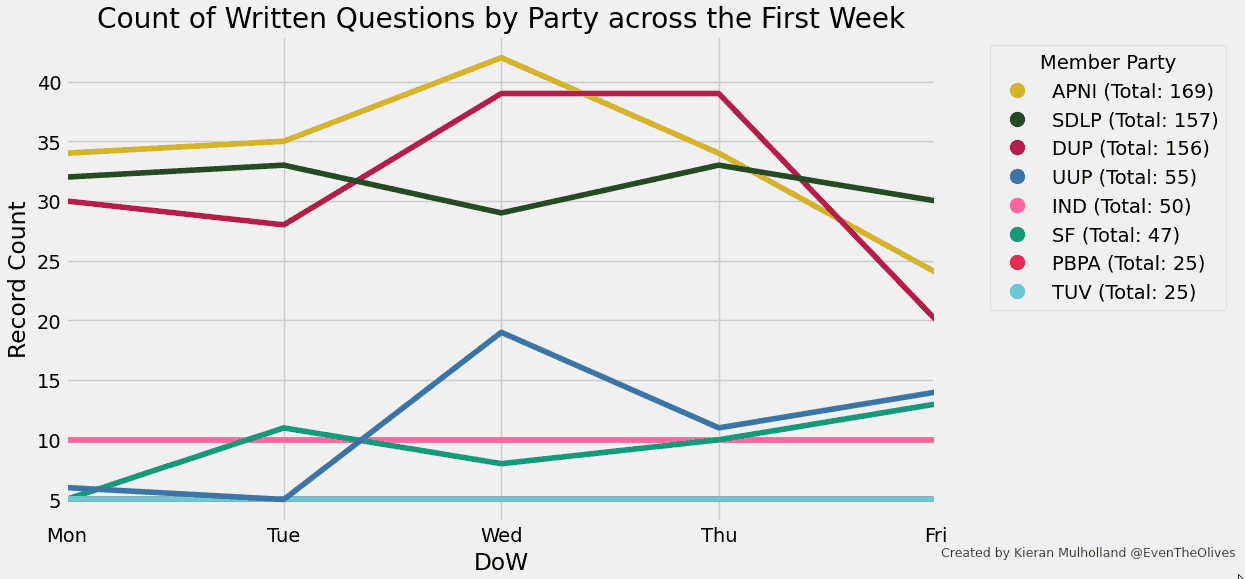
Remember, MLAs are limited to 5 written questions per day so at 25 each, those two Independents join the sole TUV and People Before Profit MLAs Jim Allister and Gerry Carroll in maxing out their entitlement. In fact, if we look instead at the average questions asked by MLAs by Party (i.e. proportionate to the number of MLAs a party has), the opposition parties (official and otherwise) lead the way versus their Executive parties counterparts.
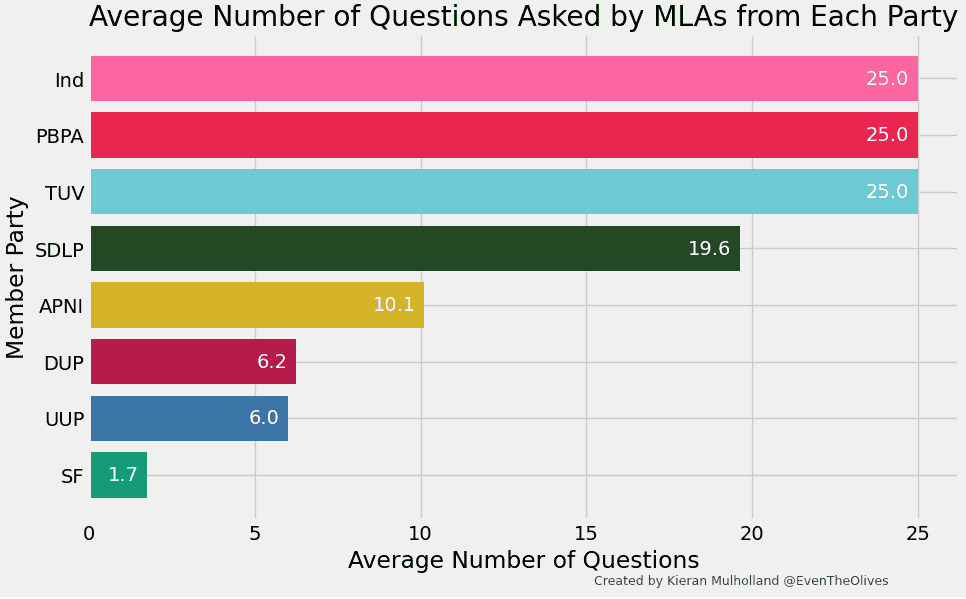
Only opposition parties (again official and otherwise) have maxed out their allowance of 25 questions across the week. Nine MLAs in total have done so, including 4 SDLP members (assuming we continue to regard Justin McNulty as such). This doesn’t however include the leader of the opposition who has submitted a paltry 9 in comparison.
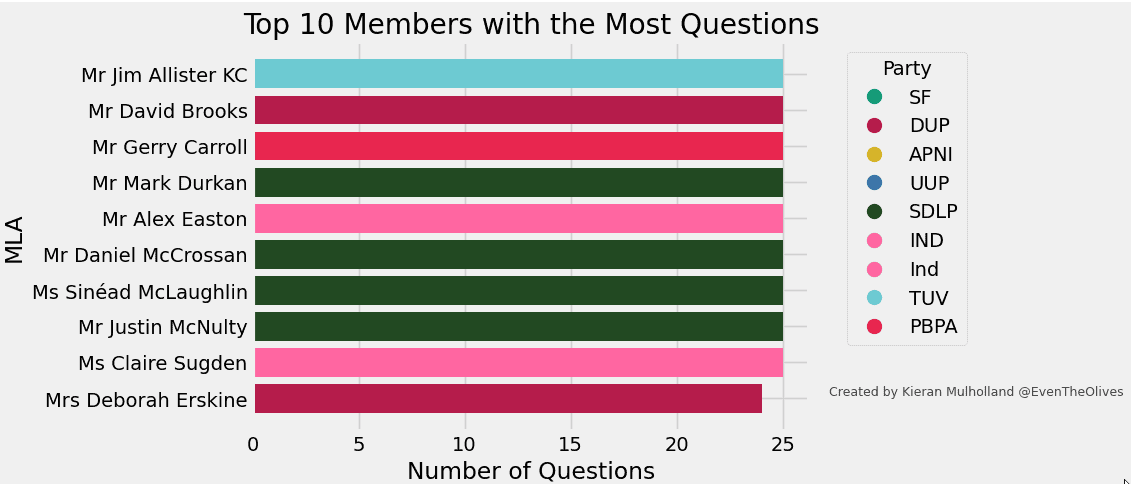
Of course, while 9 MLAs have maxed out their entitlement, 37 have opted not to submit any questions in the first week. Twenty of these are from Sinn Féin alone.

So where do the 53 inquisitive MLAs represent? The County Down is well represented at the top of the table with almost a third of all questions coming from a combination of North Down, East Belfast, and Strangford Constituencies. Lagan Valley lags behind in terms of County Down constituencies but its numbers will of course suffer as it includes 2 ministers amongst its 5 MLAs – deputy/Joint First Minister Emma Little-Pengelly and Minister of Education Paul Givan. Conversely, South and East Antrim trail at the bottom with less than 20 questions between them. Despite including a Minister amongst her 5 representatives, their county neighbour in North Antrim fairs better at 39, boosted from the presence of Jim Allister maxing out his allowance.

With the goodwill that has been expressed towards the UUP for retaking the health portfolio once again, you may have seen the SDLP’s Colin McGrath on X/Twitter assuring David McCann that Health Minister Robin Swann will be questioned and challenged as much as is required.
I shall ask any question needed and raise any matter required. We will be constructive in opposition – but certainly not idle! I’ve tabled 11 written Q’s this week and submitted an urgent oral question via the Speaker already.
— Colin McGrath 🇺🇦 (@ColinSDLP) February 9, 2024
That certainly seems to be the case across the board as it takes the largest chunk of the pie with nearly a quarter of all written questions. In fact it has received more than the Executive Office, and the Ministers of Finance, Justice and the Economy combined.
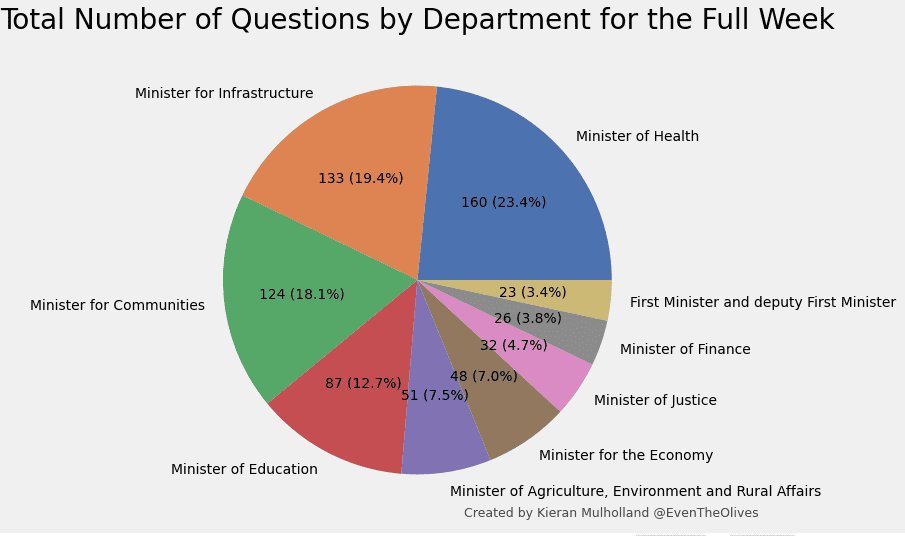
Interestingly, if we look at the breakdown by day, the Minister for Communities received the most on Wednesday but fell below the submissions to the Department for Infrastructure during the cold snap on Thursday and Friday – gritting season!
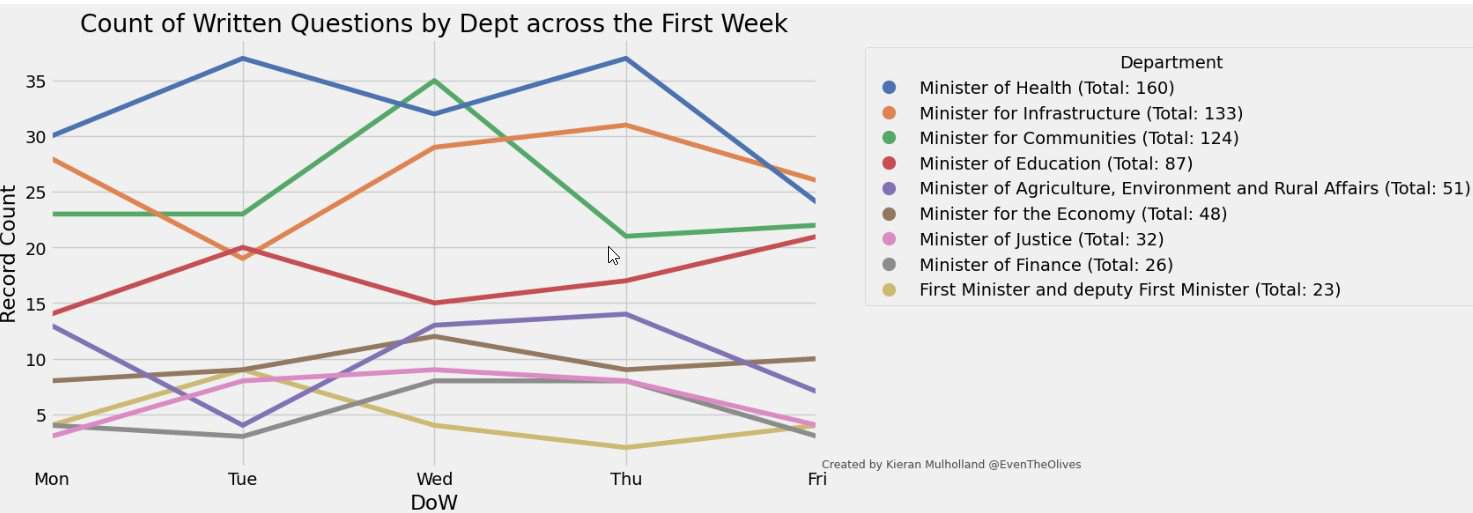
The breakdown of the Written Questions submitted to the various ministries by party is interesting too. In the stacked bar chart below, you can see the blue Health segment is prominent in all parties except for the UUP who haven’t submitted any to their party colleague. Similarly, you can see the Alliance bar is missing the pink Justice Ministry segment and the purple Agriculture, Environment and Rural affairs segment. Neither Sinn Féin nor the DUP has submitted to the Executive Office (previously OFMDFM).
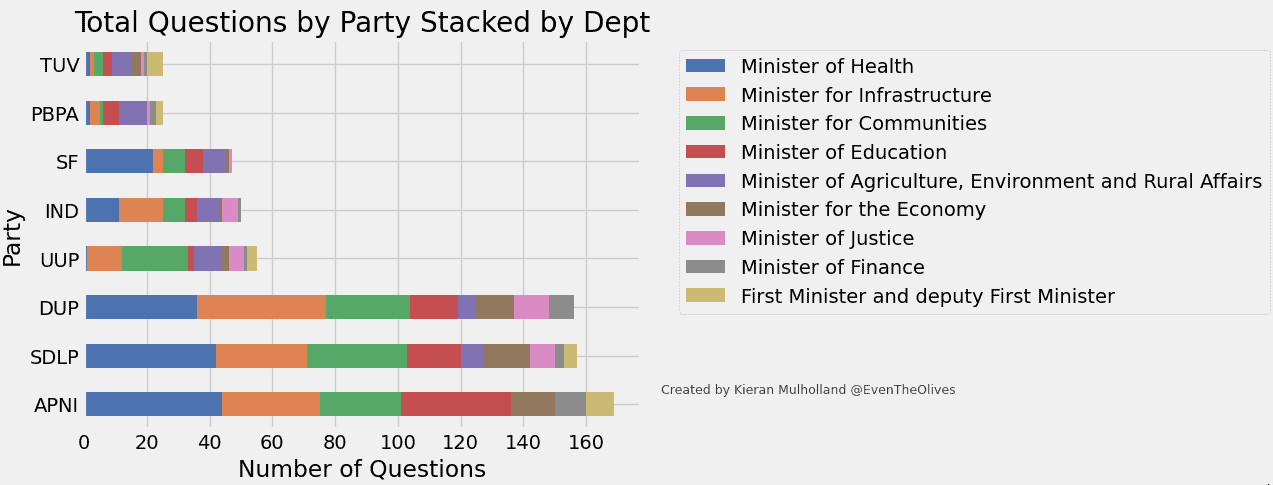
In fact, when we look at the Executive Parties in isolation, very few questions are submitted to Ministers within an MLAs own party versus Ministers from other parties.
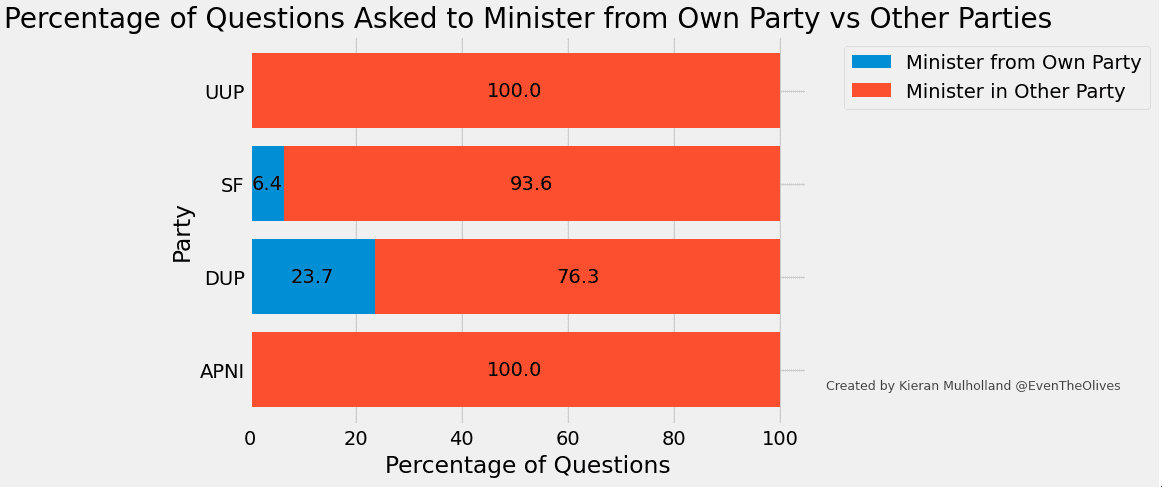
A wordcloud for some of the keywords in the Written Questions to the Minister of Health doesn’t reveal anything particularly surprising. “England” is referenced, so some MLAs are comparing our service to that across the water. “Children”, “Childrens”, “Maternity” and “Parents” appears showing a concern for paediatric and prenatal services.
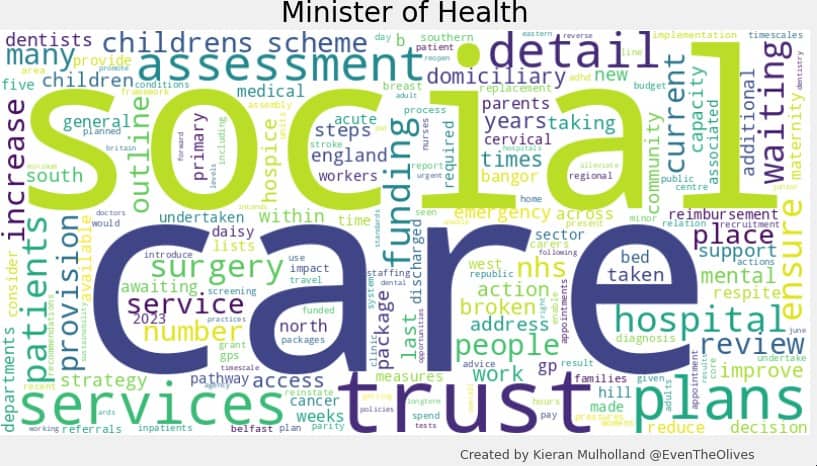
One of the more interesting wordclouds (note in the footnotes you can discover where to find wordcloud for all departments) was that for the Minister of Agriculture, Environment and Rural Affairs. Clearly the issues in Lough Neagh are prominent across multiple constituencies as we see large returns for “lough”, “neagh”, “algae” and “blooms”.
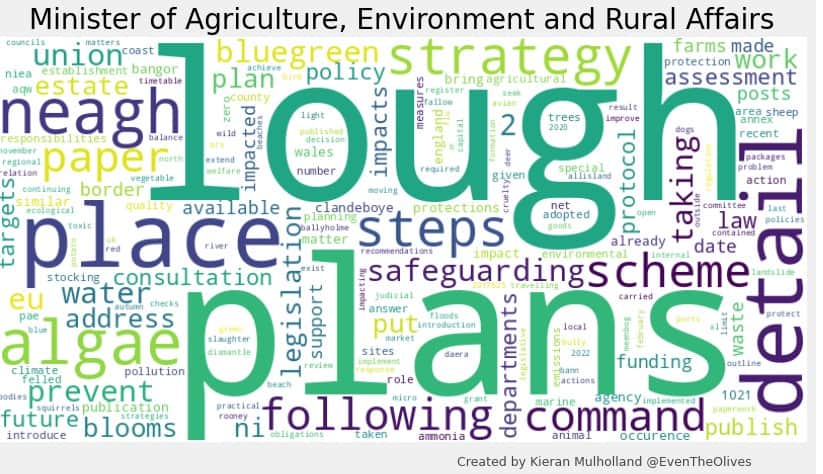
You might also notice in that wordcloud that “protocol”, “command” (as in Command Paper), and “union” feature. A keyword search for “protocol”, “Irish Sea”, “Command Paper”, and “Windsor” returned twenty questions across the departments (I didn’t search for “union” as it returns entries concerning public sector pay negotiations etc). Eighteen of those are from one MLA in particular and unfortunately we aren’t offering any prizes for guessing whom!
Of these 16, Jim Allister has submitted the same question to each of the 9 departments as follows:
To ask [the particular Minister(s)] whether there is a legislative or practical impact on his Department and its responsibilities as a result of the Command Paper, Safeguarding the Union.
The two which weren’t Mr Allister’s submissions came from Alan Chambers and Tom Elliot. Alan Chambers asked the Minister for the Economy “what plans he has to assist local business that rely on East-West trade, following the introduction of the Windsor Framework”. Tom Elliots, however, was a reference to an NIEA operational protocol so can be discounted here.
Another keyword search, this time for “Casement”, returns 6 Written Questions all submitted to the Minister for Communities. Jim Allister and Michelle McIlveen submitted 2 each, with the other two from Alan Chambers and Justin McNulty (as per the tweet above). Jim Allister used a Priority allocation for one of these submissions which asks the Minister whether he will halt the project and if not justify its continuance.
As above, these Priority Questions should be answered in 2 to 5 working days. Including this one from Jim Allister, the Minister for Communities has less than 10 priority questions to answer. Once again, it’s the Minister of Health who takes the lion’s share of the burden with double the amount of the next highest, accounting for 12% of its overall questions.

There’s plenty more detail to explore here. What are your thoughts? Are these a valuable asset to democracy to hold Ministers to account, or are the petty politicking with one eye on the potential press releases?
Footnotes:
The data was gathered from the NI Assembly website: https://aims.niassembly.gov.uk/questions/writtens.aspx
The data was interrogated in a IPython Notebook; this .ipynb file can be accessed at the author’s github: https://github.com/EvenTheOlives/NI-Assembly-Written-Questions-Week-1
This is a guest slot to give a platform for new writers either as a one off, or a prelude to becoming part of the regular Slugger team.
Discover more from Slugger O'Toole
Subscribe to get the latest posts to your email.
